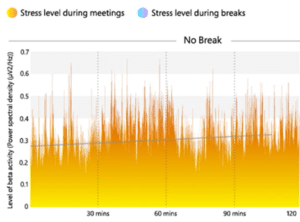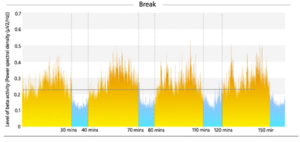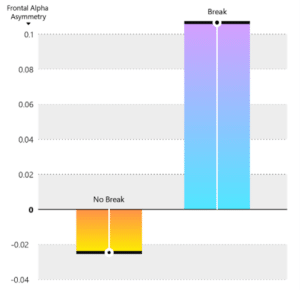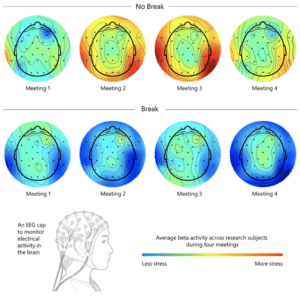‘Back-to-back’ online meetings have become a commonplace phenomenon, yet it is something that we have grown tired of. According to a study conducted by Microsoft on brainwave activity during back-to-back online meetings revealed that they are even more detrimental to our mental well-being than previously assumed. Fortunately, there is a simple yet effective solution to counteract this issue.
Microsoft’s Human Factors Lab focuses on studying the interaction between people and technology. In Microsoft’s Work Trend Index 2021, 54% of respondents reported feeling overworked, with an additional 39% describing themselves as outright exhausted. With “Zoom fatigue” officially recognised as a term in the U.S., Microsoft conducted research to delve into the root causes of this exhaustion and explore potential solutions. They invited 14 individuals to participate in video meetings while wearing electroencephalogram (EEG) equipment, which monitors electrical activity in their brains. While one group had back-to-back meetings throughout the day, the other group had short meditative breaks. The findings were even more remarkable than anticipated.
Going directly from one meeting to another can lead to spikes in stress levels
The absence of breaks can cause a sharp increase in beta wave activity in the brain during the start and end of meetings, indicating a rise in stress levels.

Illustration by Valerio Pellegrini
Observe the effects of taking meditative breaks

Illustration by Valerio Pellegrini
Instead of observing a straight-line increase, you notice a consistent pattern when breaks are taken. By taking breaks, not only are the stress spikes avoided but there is also a reduction in beta activity, which is associated with decreased stress levels.
Back-to-back meetings can have a negative impact on your focus and level of engagement
Researchers use frontal alpha asymmetry, a brain wave pattern that measures the difference between right and left alpha wave activity in the frontal area of the brain, to determine whether people are engaged or withdrawn.
In the absence of breaks, the levels of frontal alpha asymmetry were negative, indicating that the participants were less engaged or withdrawn during the meetings. However, when participants took meditation breaks, their brain wave patterns showed increased engagement during the meetings.

Illustration by Valerio Pellegrini
Breaks between meetings allows the brain to ‘reset,’ reducing accumulation of stress during meetings
As meetings progressed, the average beta wave activity kept increasing, leading to heightened stress levels. However, taking a break for meditation allowed the beta activity to decrease, facilitating a ‘reset’. This reset enabled participants to start their next meeting in a more relaxed state. The remedy for fatigue is simple: take brief breaks. Your brain functions differently when you take breaks. Taking pauses between video calls can help prevent stress.

Illustration by Brown Bird Design
How do you implement breaks into your day?
Technology is set to lend us a helping hand. Teams has introduced a feature: Personal Wellbeing Experiences. This feature is designed to provide a range of mental support to help you navigate your workday more effectively. For instance, you can use special time blocks that are aligned with your goals to start your day with greater motivation and end it feeling more fulfilled. Additionally, you will receive reminders for breaks, reflection and can evaluate your day based on your mental state. With an integration to Headspace, the feature encourages mindfulness through relaxation, reflection and even meditation, which can significantly benefit your mental state throughout the day.
Let’s give it a shot! Below are some additional pointers that may seem obvious, but we are highlighting them once again with the hope that you will put them into practice:
1. Avoid scheduling back-to-back meetings whenever possible.
2. Allow yourself a minimum of 10 minutes to reflect on the previous meeting and prepare for the upcoming one.
3. Use your break time to truly unwind and recharge. For instance, you could take a stroll, meditate, play an instrument or practice juggling.
4. Schedule any meetings taking place between 1:00 p.m. and 2:00 p.m. as walking meetings held outdoors.
5. Think outside the box when it comes to addressing issues. Sometimes a meeting is not necessary.
6. Conduct effective meetings by having a clear agenda and identifying each attendee’s role.
7. Keep participants interested and energized throughout the meeting. (or: sign up for our Remote Meeting Skills training!)
7. Keep participants engaged and energised. (In other words: Sign up for our Remote Meeting Skills training! 😉)





